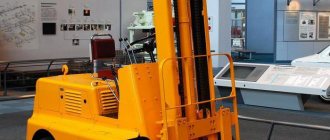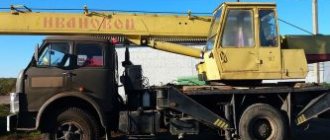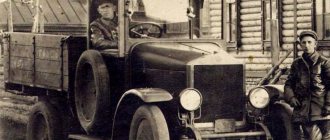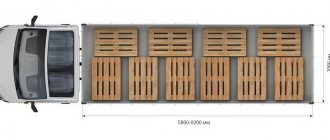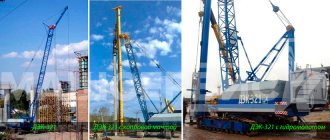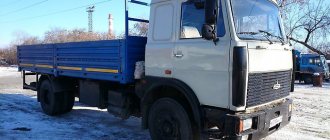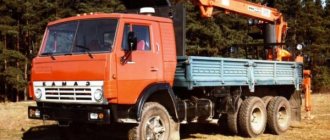ZIL 130 is a legendary truck of the Soviet era. In the line of the Likhachev plant, the model is the most widespread and successful product. The production of the car was organized at various enterprises, and the total production volume exceeded 3 million copies. The ZIL 130 has been on the assembly line of the Likhachev plant since 1964 and for a long time remained the standard in the medium-tonnage truck segment. For that period, this was a progressive model with high rates of profitability and durability.
The car was used in various fields, and the number of versions created on its basis reached several dozen. By the end of the 1980s, the ZIL 130 was seriously outdated. The design of the model, which had changed slightly since the start of production, no longer provided a competitive advantage. As a result, the car gave way to more progressive analogues. Currently, the ZIL 130 is difficult to find on the roads of the country. However, individual enterprises and farms continue to use this model.
How much does a fuel tanker weigh?
Tank
- suitcase section. Gross weight, kg - 43000. Gross weight, kg - 30000.
Interesting materials:
What types of geotechnical work are carried out during surveys? What types of work are included in reconstruction? What types of work are included in engineering geodetic surveys? What types of construction work are classified as major renovations? What should a standing desk be like? What kind of glue do shoemakers use? What device is used to measure the work of electric current in practice? What instrument can you use to measure work? What is the conjugation of the verb work? How long should a kitchen work surface be?
MODIFICATIONS
The ZIL 130 series included a huge number of modifications. Among the basic versions it is customary to distinguish:
- ZIL 130 (1962-1966) - the first basic model of the series (onboard version/chassis) with a ZIL-130 unit (150 hp) and a load capacity of 4-5.5 tons. Service life - 135,000 km;
- ZIL 130-66 (1966-1978) - a modernized version of the basic version of 1966. The car was equipped with a 150-horsepower engine and had minor design changes that increased its service life to 200,000 km. The vehicle's carrying capacity was 5 tons;
- ZIL 130-76 (1978-1984) – 1976 model with a service life of 300,000 km and a load capacity of up to 6 tons;
- ZIL 130-80 (1984-1986) - the basic version of 1980, equipped with 3 independent brake systems.
Based on basic modifications, models with more specific functionality were created:
- ZIL 130A is an onboard vehicle for use with a trailer (total weight up to 8 tons). The vehicle package included a combined brake valve, electrical outlets and a towbar;
- ZIL 130G – flatbed truck with an extended wheelbase (4500 mm) and a body with 2-section side walls;
- ZIL 130V – shortened truck tractor (wheelbase – 3300 mm);
- ZIL 130VT – analogue of ZIL 130V with a reinforced rear axle;
- ZIL 130D – shortened chassis for assembling construction dump trucks;
- ZIL 130B – chassis with a medium wheelbase (3800 mm) for agricultural dump trucks.
Control
The legendary truck was controlled thanks to the steering mechanism. It was built on the principle of a nut and screw. It also had power steering installed. The steering column was located in the cockpit. The three-spoke steering wheel is made of plastic.
In the export versions of the truck, which were planned to be sent to African countries, an additional radiator was installed that cooled the vehicle’s working fluids.
SPECIFICATIONS
Dimensions:
- length – 6675 mm;
- width – 2500 mm;
- height – 2400 mm;
- wheelbase – 3800 mm;
- ground clearance - 270 mm;
- minimum turning radius – 8900 mm;
- front track – 1800 mm;
- rear track – 1790 mm.
The curb weight of the ZIL 130 is 4300 kg, the total weight is 10525 kg. Load distribution (empty/fully loaded): front axle – 2120/2625 kg, rear axle – 2180/7900 kg. The maximum weight of a towed trailer is 8000 kg.
ZIL 130 is capable of speeds of up to 90 km/h. At a speed of 60 km/h, let the brake brake be 28 m. Average fuel consumption at a speed limit of 60 km/h is within 29 l/100 km. The car's fuel tank holds 170 liters of fuel.
Platform characteristics (onboard version):
- length – 3752 mm;
- width – 2326 mm;
- side height – 575 mm;
- loading height – 1450 mm.
Brakes
The truck's drum brakes were equipped with a pneumatic drive. For pneumatic operation, compressors with two cylinders, as well as receivers with a capacity of 20 liters, were developed.
The handbrake on the first ZIL-130 models could be activated using a lever in the cockpit. When it was turned on, the brake mechanism, which is located on the output shaft of the manual transmission, was activated.
All ZIL trucks are equipped with an outlet for connecting pneumatic trailer brakes to it. This equipment is located at the rear of the vehicle on the frame cross member next to the tow hook.
On later truck models, separate brake drives were installed on the rear and front axles. They are able to adjust the force to prevent skidding.
The handbrake has also undergone changes. On the updated version of the ZIL-130, a separate pneumatic system was used, which did not allow the car to move from a parking lot. She was also responsible for emergency stopping of the car in case of failure of the main drum brakes.
Engine
The V-shaped eight-cylinder 4-stroke engine ZIL-130 has an economical volume of about 6 liters. At first, the truck’s engine was carburetor-powered, but after 10 years of use, a model version with natural gas was launched. If it is gasoline, the fuel consumption of the ZIL-130 per 100 km is approximately 30 liters. In this case, you can use inexpensive A-72 or A-76 fuel. The technical nuances of the engine are shown in the table.
| Power scheme | Carburetor |
| Number of valves | 2 |
| Number of cylinders | 8 |
| Position | Front, longitudinal |
| Power in hp |
135-150
Models have also been developed for cold climate zones with pre-heating.
Exterior of the body and cabin
The truck's cab was all-metal and had two doors. Its volume allowed it to accommodate up to three people: a driver and two passengers. For the winter season, a stove is installed in the car. Wipers are located on the windshield. The windows on the doors are lowered and raised manually, and there are rotating triangular windows next to them. On the roof of the first car models, holes were made for interior ventilation, but later the designers abandoned such a technological solution.
Until 1974, trucks did not have turn signals. Later, modified versions featured yellow turn signals on the car's fenders.
For civilian purposes, a solid windshield was installed in the ZIL cab. In the army version of the truck, the windshield consisted of two halves of the same size.
Depending on the modification, there were two types of radiator grille trim on the outside of the cabin:
- Small slots for air duct. The headlights are installed in the lower part of the cab above the bumper.
- The headlights are located above the radiator grille. To cool the radiator, large holes were made in the front of the cabin.
The truck's side platform is made of wood; a metal reinforcement was additionally installed to strengthen the structure. The standard platform consisted of two sides on the sides of the car. The extended version of the 130GU has three sides. To store tools that could be useful in the event of a machine breakdown, space was provided in the cabin under the floor.
ZIL-130 Fuel consumption Dimensions Load capacity Tank volume
ZIL-130 (ZIL-431410) is a Soviet and Russian truck developed and produced by the Likhachev Automobile Plant in Moscow. One of the most popular cars in the history of the Soviet automobile industry, it was widely used in the national economy and the army, and was exported. Replaced ZIL-164. Since 1986, it was produced under a new standardized index - ZIL-431410.
Truck transmission
To develop a gearbox for ZIL, a unit was taken from an outdated ZIS-150 truck. The transmission has five gears for forward movement. The top four gears have a synchronizer. Fifth speed straight. The dry clutch with one disc is equipped with a mechanical drive.
For tractors and dump trucks, the designers wanted to develop a two-speed rear axle, with the ability to change gears using a clutch, but the unit could not be put into mass production as a result of numerous shortcomings. Subsequently, it was decided to equip all ZIL modifications with a single-speed rear axle.
ZIL-130 - video review
Great Soviet Encyclopedia. Volume one. The letter a". In the “Car” section the title image is “ZIL-130”. This says a lot. “ZIL-130” is the most popular car in the history of the capital’s Likhachev Automobile Plant. Only at ZIL, excluding those manufactured at other enterprises, 3,366,503 trucks of this brand were produced. The ZIL-130 model was on the assembly line of the Moscow plant from 1964 to 1994, and it was not without reason that for a couple of decades it was considered practically the standard for a medium-duty truck. In fact, for that time it was a progressive car in all respects - reliable, durable, unpretentious and cost-effective to operate.
About the history of the model
In the model range it replaced the ZIL-164. The 164th ZIL, a deep modernization of the ZIS-150, launched into production in 1957, turned out to be only a “temporary solution.” The national economy needed a qualitatively new truck. When the main model was changed, the space under the hood of the in-line six-cylinder ZIL-120 engine gave way to a new V-shaped eight-cylinder engine.
From prototypes to the assembly line, the 130th took six years to complete. At that time, the truck turned out to be truly innovative, unlike its predecessors, and, by the way, with a level of comfort unprecedented for a Soviet driver. The steering was equipped with a hydraulic booster, and the five-speed gearbox was equipped with synchronizers for all but the first gear. The car moved off easily from the second, and the first stage was actually needed only for off-road conditions or very steep climbs.
The appearance of the car also turned out to be extremely innovative and bold, with a strong personality, even by international standards. Another feature of the new mass-produced ZIL truck was the coloring - no longer dark green khaki (although such were also produced, of course), but quite “civilian”. There were different options, but the individual, “branded” color of the 130s ZILs was a sky blue cabin with a white front end.
There is no doubt that in 1964 a qualitatively new model of a medium-duty truck was launched into mass production, which, in terms of all the main indicators, was on par with the most modern, at that time, vehicles of European and American companies.
ZIL-130 cars of the first years of production (1964-1966) were equipped with a carburetor engine of the same name with a capacity of 148 horsepower, and had a standard load capacity of 5.5 tons for paved roads, and 4 tons for unpaved roads. The motor had a declared service life of 135 thousand kilometers before major repairs.
After modernization in 1966, engine power reached 150 horsepower; its working life is set at 200 thousand kilometers before overhaul. And the vehicle’s carrying capacity was set at 5 tons, regardless of the type of road surface.
The modernization of 1976 brought the load capacity of the basic ZIL-130 model to six tons, and the engine life before overhaul to 300 thousand kilometers. Truck tractors made on the basis of the ZIL-130 were used to tow trailers with a total weight of 10.5 tons (ZIL-130V1); 12.4 tons (“ZIL-130V1-66”); 14.4 tons (“ZIL-130V1-76”). The 1976 version is easily distinguished by its modified front part (the sidelights and headlights have swapped places). And in 1986, the car received another production index - 431410, in accordance with the industry-standard index system.
In 1973, the state certification commission decided to assign the ZIL-130 brand the USSR State Quality Mark. This was quite natural, since the main model of the ZIL truck actually regularly received many favorable reviews from enterprises and farms that operated these trucks.
80s of the twentieth century. Chassis "ZIL-130" in the workshop of the Likhachev Plant
In practical tests, the ZIL-130 showed truly impressive results. Both during a long run in the Far North and during large-scale endurance tests in May 1973 at the NAMI test site, when the 130s covered a distance of 25 thousand kilometers in 12 days, without a single breakdown.
The anniversary millionth ZIL-130 truck rolled off the assembly line of the Likhachev plant in June 1974, and in August 1982 the two millionth ZIL-130 was manufactured. Interestingly, both anniversary 130s had the same “owner.”
The millionth bright red truck was solemnly presented to the best driver of the Third Automotive Plant of GlavMosAvtotrans, Alexey Beschastnov. And years later, when the two-millionth ZIL-130 was assembled, it was handed over again to the same driver, who, by the way, had not committed a single accident on his millionth ZIL-130 over the entire period, and remained among the best drivers trucks in the capital.
In addition to the capital enterprise, the 130th ZILs were produced, starting in the 70s, also at the Ural Automotive Plant (Novouralsk, Sverdlovsk Region) and the Chita Automobile Assembly Plant.
Frame and suspension "ZIL-130"
The “ZIL-130” frame is stamped, riveted, with channel-section spars, connected by cross members. The truck's hitch is equipped with a latch-type tow hook at the rear and two non-latch tow hooks at the front. The suspension of the front and rear axles is dependent, located on longitudinal leaf springs; the front ends of the front and rear springs are fixed to the frame using detachable lugs and pins, and the rear ends of the springs are sliding.
Shock absorbers installed on the front suspension are hydraulic, telescopic, double-acting. The standard spring suspension of the ZIL-130 was borrowed for the fourth generation GAZ trucks.
Engine
The ZIL-130 truck was equipped with a carburetor eight-cylinder 4-stroke V-shaped overhead valve engine of the same brand - ZIL-130. Working volume – 5969 cm³.
— Power – 150 horsepower, at 3200 rpm (with limiter). — Cylinder diameter – 100 mm; The piston stroke in the cylinder is 95 mm. — Compression ratio — 6.5. — Maximum torque at 1800/2000 rpm. – 401.8 Nm (41 kgf-m). — Fuel consumption – 29 liters per 100 km, with an average vehicle speed of 60 km/h.
The location of the cylinders in this engine is at an angle of 90 degrees. The cylinder block has liners, with rubber sealing rings in their lower part. There are two cylinder heads, they are made of aluminum alloy with insert seats and valve guides. The pistons are made from the same aluminum alloy. There are three piston compression rings. 2 upper ones are chrome-plated cast iron, and one oil scraper is steel, composite, chrome-plated. Piston pins are steel, floating, hollow. The connecting rods are made of steel, I-section, with lubricated piston pin.
Connecting rod and main bearings are thin-walled, interchangeable; liners - steel-aluminum (steel tape and aluminum alloy). Crankshaft - steel, forged, five-bearing, with lubrication channels; necks with dirt traps. The flywheel is cast iron, equipped with a steel ring gear for starting the engine from the starter. The camshaft is steel, five-bearing.
The valves of the ZIL-130 engine have the following design. Intake - located in the cylinder heads. They are driven by a single camshaft. Exhaust outlets are hollow, cooled, with heat-resistant surfacing; have a mechanism for forced rotation of the valve during operation. The pushers are mechanical, made of steel, coated with special cast iron. The valve rocker arms are steel, with bronze bushings.
The gas pipelines of the ZIL-130 engine are as follows: intake - made of aluminum alloy, common to each of the cylinder rows, with a liquid cavity for heating the fuel mixture, located between the block heads; graduations - made of cast iron; one on each side of the cylinder block.
The fuel tank of the ZIL-130 car is installed under the platform on the left side member and has a volume of 170 liters. The power system uses the principle of forced fuel supply; the B-10 fuel pump is a diaphragm pump, with a lever for manual pumping of gasoline. Heating of the fuel mixture - in the intake gas pipeline, which has a special liquid cavity for heating, the fuel mixture is heated.
The cooling system of the ZIL-130 engine is liquid, closed, with forced circulation. A tubular-ribbon radiator, serpentine, three-row, is installed. The thermostat (with solid filler) is installed in the outlet pipe of the liquid cavity. Blinds – folding, vertical, controlled from the driver’s cab. The centrifugal water pump is driven by a belt from the crankshaft pulley, together with a six-bladed engine fan.
“ZIL-130” – “collective farmer”
Transmission "ZIL-130"
ZIL-130 vehicles are equipped with a standard five-speed manual gearbox. The gearbox is equipped with two inertia-type synchronizers for engaging second and third, fourth and fifth gears. The main gear is double, with a pair of bevel gears with spiral teeth and a pair of cylindrical gears with helical teeth, with a gear ratio of 6.32.
The clutch is dry, single-plate, with a spring-loaded torsional vibration damper. The number of pairs of rubbing surfaces is 2. The drive is distributed to the rear axle, the front axle is the steering axle.
There are two cardan shafts, open type, with an intermediate support on the frame. There are three universal joints, on needle bearings, with a constant supply of lubricant. Rear axle housing – steel, stamped, welded. A bevel differential is installed, symmetrical, with four satellites. The axle shafts are completely unloaded. The standard tire size is 260x508.
And in the 21st century it’s easy to find a ZIL-130 on Cuban roads
Brake control "ZIL-130"
The truck's pneumatic braking system operates on drum mechanisms. The working brake system is a shoe, drum type; acts on all wheels, its drive is pneumatic. The parking brake system is also of the drum type, acting on the transmission; its drive is mechanical. A two-cylinder air compressor is installed, with liquid cooling of the head and block.
Air compressor pistons are made of aluminum alloy, with floating piston pins. The compressor is driven by a belt from the water pump pulley; The compressor is lubricated by the engine lubrication system, under pressure and splash.
Review of basic and serial modifications of the ZIL-130
Initially, even before design, the ZIL-130 was considered as the basis for a wide family of unified vehicles intended for a wide variety of transport and business operations. These plans found their full implementation. Therefore, the complete list of modifications based on the ZIL-130 includes, along with experimental options, many dozens of items.
Along with the basic models of flatbed truck and dump truck, the ZIL-130G family was also produced - with a wheelbase extended to 4.5 m, ZIL-130V truck tractors, ZIL-130S modifications for operation in northern conditions and the tropics, gas-cylinder versions and etc.
"ZIL-130", until the end of the 80s of the twentieth century, had good export potential. It was supplied to more than forty countries around the world. Moreover, at the request of the customer, the car was equipped with an economical English 140-horsepower Perkins diesel engine. The plant has developed versions of all popular ZIL-130 modifications adapted for countries with tropical climates.
The Finnish subsidiary of the Soviet "Avtoexport" - - supplied a supporting non-driving axle under a two-axle vehicle, which increased the vehicle's load capacity to 8 tons. Special chassis based on the extended version of the "ZIL-130G" were supplied to India, Syria, Iran and Iraq, for which local body companies installed the bodies of trucks and buses with their original, sometimes very bizarre, designs.
The ZIL-130 chassis was extremely popular for the manufacture of all kinds of specialized vehicles. Vans and tankers, fuel tankers and drilling rigs, truck cranes and mobile workshops, firefighters, garbage disposals, watering and washing machines - there were countless different models of special vehicles on the 130th chassis.
"ZIL-130V" - truck tractor
Modifications of "ZIL-130" (only basic and serial):
“ZIL-130” is a basic vehicle (both flatbed and universal chassis), the first production version with a ZIL-130 engine with a power of 148 hp. With.
“ZIL-130-66” - modification of 1966, with increased hp to 150. engine power and a number of design improvements.
"ZIL-130-76" - the basic version of the 1976 model. The carrying capacity is increased to 6 tons, and the working life is up to 300 thousand km.
"ZIL-130-80" - modification of 1980, equipped with three independent braking systems.
"ZIL-130A" - onboard tractor.
“ZIL-130B” is a special chassis equipped with a combined brake valve, towing device, pneumatic and electrical outlets for connecting the brake system and electrical devices of the trailer, for agricultural dump trucks-tractors “ZIL-MMZ-554” and “ZIL-MMZ-554M” "(wheelbase 3.8 m).
"ZIL-130V" - truck tractor
"ZIL-130VT" is a truck tractor with a reinforced rear axle.
Long wheelbase "ZIL-130G"
“ZIL-130G” – flatbed and universal chassis, long-wheelbase (with a base of 4.5 m).
"ZIL-130GU" - especially long-wheelbase (5.6 m), using components from
"ZIL-133/G1".
Popular industrial dump truck "ZIL-130D" with a practical "trough-shaped" body
"ZIL-130D1" - chassis for industrial dump trucks "ZIL-MMZ-555" and "ZIL-MMZ-4502".
"ZIL-130D2" - a chassis equipped with a combined brake valve, towing coupling device, pneumatic and electrical outlets for connecting the brake system and electrical devices of the trailer, for industrial dump trucks-tractors "ZIL-MMZ-555A" and "ZIL-MMZ-45022" .
“ZIL-130D3” is a chassis equipped with a combined brake valve, towing device, pneumatic and electrical outlets for connecting the brake system and electrical equipment of the trailer, for a special dump truck tractor (wheelbase 3300 mm).
“ZIL-136I” is a car with a Perkins-6.345 diesel engine with a power of 140 hp. With.
“ZIL-136IG” is a long-wheelbase (wheelbase 4.5 m) vehicle with a Perkins-6.345 diesel engine with a power of 140 hp. With.
"ZIL-136ID1" - a chassis for an industrial dump truck, with a Perkins-6.345 diesel engine (wheelbase 3.3 m).
"ZIL-130K" chassis with a "ZIL-157D" engine with a power of 110 hp. pp., for industrial dump trucks “ZIL-MMZ-555K” and “ZIL-MMZ-45021” (wheelbase 3.3 m).
“ZIL-138”, “ZIL-138A” and “ZIL-138I” are gas-cylinder versions of the 130th, designed to operate on liquefied gas. Including: “ZIL-138V1” – truck tractor;
“ZIL-138D2” – chassis for an industrial dump truck-tractor; “ZIL-138AG”, “ZIL-138I” - long wheelbase.
Additional letter designations in the names of all modifications indicated in this list mean: “E” – export version for countries with a temperate climate; “T” – export option for countries with a tropical climate; “C” – for Siberia and the Far North; “E” – with shielded electrical equipment.
Cabin of the ZIL-130 car
The ZIL-130 cabin is a three-seater all-metal cabin, equipped with a panoramic windshield with a washer. The cabs of early cars had two ventilation hatches in the cab roof and an air duct hatch on the left side of the cab above the clutch pedal. Subsequently, all these hatches were gradually removed, one after another.
The equipment of the ZIL-130 cabin, by today's standards, is rather meager, the furnishings are spartan. At that time, few trucks could offer the driver and passengers greater comfort. Indeed: the cabin interior is spacious, the seating is comfortable, all control devices are conveniently located, gears are switched easily, and the hydraulic booster helps turn the steering wheel. From second gear the 130 starts off very easily and accelerates very confidently.
The ZIL-130 cabin has good acoustic comfort. It is much quieter here than in the cabins of other “classmates” trucks from the twentieth century. With a properly tuned ZIL-130 engine, the compressor can be heard better than the engine itself - the engine does not “growl” for the driver and passengers sitting in the cabin, but simply “rustles”.
The only drawback (insignificant in the twentieth century, but important now) is poor visibility from the driver's seat. The high hood and front fenders cause discomfort when driving in heavy traffic or on tight city streets.
Cost of the ZIL-130 car
The used car market in any region of the Russian Federation is saturated with offers for the sale of ZIL-130 trucks of all kinds and modifications (primarily, dump trucks, of course, industrial and agricultural). Which is not surprising, given the huge number of machines built over the years of production and their total prevalence in all sectors of the economy.
The price range is huge. Depending on the year of manufacture, equipment and technical condition, for a used ZIL-130 car they ask from 50 to 300 thousand rubles. Special vehicles equipped with special equipment, such as a crane-manipulator, are even more expensive - the asking price for them reaches half a million rubles.
Cost of the ZIL-130 car
The used car market in any region of the Russian Federation is saturated with offers for the sale of ZIL-130 trucks of all kinds and modifications (primarily, dump trucks, of course, industrial and agricultural). Which is not surprising, given the huge number of machines built over the years of production and their total prevalence in all sectors of the economy.
The price range is huge. Depending on the year of manufacture, equipment and technical condition, for a used ZIL-130 car they ask from 50 to 300 thousand rubles. Special vehicles equipped with special equipment, such as a crane-manipulator, are even more expensive - the asking price for them reaches half a million rubles.
Electrical diagram of ZIL-130
Reviews from drivers and owners of ZIL-130
A man who worked all his life as a driver on a collective farm recalls that until the mid-70s, trucks from the Gorky Automobile Plant dominated the fleet of agricultural enterprises. Subsequently, as the welfare of collective farms strengthened, they began to purchase more and more ZIL-130 vehicles. Drivers and engineers of agricultural enterprises very soon appreciated how much stronger, more reliable, more durable and more profitable this vehicle was than Gorky trucks (no offense to the good old “GAZ-51, 52, 53”).
“The one hundred and thirtieth is much stronger than the GAZ in its design, has a more reliable and resource-rich engine, has excellent maneuverability and cross-country ability, and can easily go along the highway. The car is reliable and versatile.”
On the other hand, the opinion of the 130th from a native city resident, who in his driver’s biography also worked not only at GAZon, but also at KamAZ, is also interesting.
“I really love the ZIL-MMZ-555 dump truck, I consider it the most combative. This unique trough-shaped body – bravo to the general designer! Magnificent car! I worked on the 130 for four years and didn’t have any problems with it. We had a lot of ZILs at our car depot, and they were not written off, since they always did their job without any problems, despite their uneconomical nature. It compensated very well without the need for spare parts. One engine is worth it! Powerful and durable."
ZIL-431410 “Agricultural worker” of the Amur assembly
Since those times, when there were still “cats crying” at the KamAZ truck depots, the entire burden of transport transportation fell fully on the “shoulders” of the “ZIL-130”, and the entire colossal amount of work was carried out in the USSR by trucks of this particular model.
One of the features of the ZIL-130 is that the height of the body is equal to the height of the floor of the railway car. This greatly simplifies the loading and unloading conditions: you can directly drive up to the car and reload in the shortest possible time.
Nowadays, the ZIL-130 is, of course, a hopelessly outdated machine. Competitive and practically flawless for the 70s/80s of the twentieth century, in the twenty-first century it can no longer compete with modern medium-duty trucks either in compactness and maneuverability, or in comfort, or in efficiency. For the conditions of the multiply denser traffic flow of modern cities, the ZIL-130 is very poorly suited.
Nevertheless, many 130s, primarily those converted to gas equipment, or equipped with the MMZ D-245 diesel engine, continue to operate successfully in many enterprises and farms. “ZIL-130” is like a pensioner who has long earned honor and peace, but does not want to part with active work and activity. There is no doubt that we will often see trucks of this brand on the roads of Russia and other republics of the former Union for many years to come.
